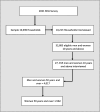Older women's well-being during the COVID-19 pandemic: individual, community, and contextual factors
- PMID: 39726685
- PMCID: PMC11669703
- DOI: 10.3389/fgwh.2024.1484469
Older women's well-being during the COVID-19 pandemic: individual, community, and contextual factors
Abstract
Objective: This article aims to examine the influence of individual and community-contextual factors on the well-being of older women in Zambia during the COVID-19 pandemic, drawing on Bronfenbrenner's process-person-context-time model.
Methods: Secondary data from the nationally representative 2021 SEIA were used, and bivariate and logistic regression analyses were performed to determine factors associated with the well-being of older women during the COVID-19 pandemic.
Results: Overall, 29% (613) of older women reported a decline in their well-being due to COVID-19. Older women in rural areas had lower odds of well-being [Adjusted Odds Ratio (AOR) 0.607, 95% 0455,0.809]. At the individual level, the well-being of older women during COVID-19 was associated with age (AOR O.362, 95% CI: 0.190,0.689) and being in paid work (AOR 0.737, 95% CI: 0.552,0.984). Despite education having a strong relationship with well-being, it had a weak effect on the well-being of older women during COVID-19. Community-level factors significantly associated with the well-being of older women amidst COVID-19 included attendance at public gatherings (e.g., church meetings, funerals) (AOR 1.465, 95% CI: 1.139,1.885) and perceived fear or anxiety due to COVID-19 (AOR 0.522, 95% CI: 0.392,0.696). A significant contextual-level factor was access to transport services during the pandemic (AOR 0.589, 95% CI: 0.390,0.890).
Conclusion: COVID-19 has exposed the inadequacy of systems at different levels in meeting the needs of older women and promoting their well-being during emergencies. At the individual level, there is a need to support older women's livelihoods and educational opportunities. Despite limitations on social interactions during COVID-19, access to social gatherings and interactions supported older women's well-being. However, this was hampered by fear of contracting COVID-19 and the limitations in public transport that compromised their mobility to access services and visit people. A more extensive analysis of individual, community, and contextual factors should identify factors that support or compromise the well-being of older women during emergencies or shocks. There is a need for information about what livelihood strategies during and/or post shocks, or critical events such as COVID-19 could sustainably support older women's well-being.
Keywords: COVID-19; Zambia; individual and community-contextual factors; older women; well-being.
© 2024 Banda, Hoffman and Roos.
Conflict of interest statement
The authors declare that the research was conducted in the absence of any commercial or financial relationships that could be construed as a potential conflict of interest.
Figures
Similar articles
-
Sexual violence and unmet need for contraception among married and cohabiting women in sub-Saharan Africa: Evidence from demographic and health surveys.PLoS One. 2020 Nov 3;15(11):e0240556. doi: 10.1371/journal.pone.0240556. eCollection 2020. PLoS One. 2020. PMID: 33141830 Free PMC article.
-
What factors influence women's empowerment in Ethiopia? A multilevel analysis of Ethiopia's demographic and health survey data.Front Glob Womens Health. 2024 Oct 31;5:1463157. doi: 10.3389/fgwh.2024.1463157. eCollection 2024. Front Glob Womens Health. 2024. PMID: 39545000 Free PMC article.
-
Delay in timing of first antenatal care utilisation among women of reproductive age in sub-Saharan Africa: a multilevel mixed effect analysis.J Health Popul Nutr. 2025 Apr 28;44(1):139. doi: 10.1186/s41043-025-00857-8. J Health Popul Nutr. 2025. PMID: 40296180 Free PMC article.
-
Gender Norms and Gender Equality in Full-Time Employment and Health: A 97-Country Analysis of the World Values Survey.Front Psychol. 2022 May 31;13:689815. doi: 10.3389/fpsyg.2022.689815. eCollection 2022. Front Psychol. 2022. PMID: 35769749 Free PMC article.
-
Antenatal Care Service Utilization of Pregnant Women Attending Antenatal Care in Public Hospitals During the COVID-19 Pandemic Period.Int J Womens Health. 2020 Dec 8;12:1181-1188. doi: 10.2147/IJWH.S287534. eCollection 2020. Int J Womens Health. 2020. PMID: 33335430 Free PMC article.
References
-
- Perez-Brumer A, Balasa R, Doshi A, Brogdon J, Doan T, Oldenburg CE. COVID-19 related shifts in social interaction, connection, and cohesion impact psychosocial health: longitudinal qualitative findings from COVID-19 treatment trial engaged participants. Int J Environ Res Public Health. (2022) 19(16):10264. 10.3390/ijerph191610264 - DOI - PMC - PubMed
-
- World Health Organisation (WHO). WHO COVID-19 dashboard. (2024). Available online at: https://data.who.int/dashboards/covid19/cases (accessed July 02, 2024).
LinkOut - more resources
Full Text Sources





